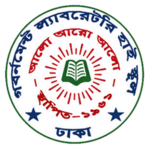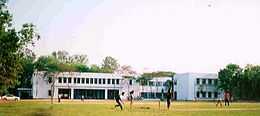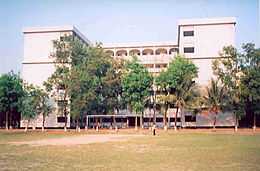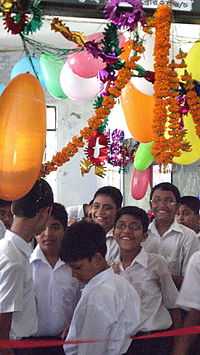Government Laboratory High School
| Government Laboratory High School | |
|---|---|
 | |
| Address | |
|
1 Naem Road, Dhanmondi, Mirpur Road, Dhaka 1205 Dhaka Bangladesh | |
| Coordinates | 23°44′9.97″N 90°22′54.15″E / 23.7361028°N 90.3817083°E |
| Information | |
| Type | Public boys school |
| Motto | Alo aro alo {Light, more light(With knowledge)} |
| Established | 3 September 1961 |
| Grades | 1-12 |
| Campus | Urban |
| Color(s) | White and Navy blue |
| Nickname | Laboratorians, Lab, Govt Lab |
| Accreditation | Board of Intermediate and Secondary Education, Dhaka |
| Yearbook | Anushilon |
The Government Laboratory High School (Govt. Lab.) is a school located in Dhanmondi, Dhaka, Bangladesh. The school was established on 3 September 1961.[1]:155
History


The Principal of the nearby Teacher's Training College, Muhammad Osman Gani, sought to establish a facility to assist his trainees practice teaching. From this idea Government Laboratory High School was created. The school was inaugurated in 1961 by the then Director of the Department of Public Instruction(D.P.I), Muhammad Shamsul Haque. The first Headmaster was Khan Muhammad Salek, who went on to serve for 12 years.[1]:155 Below is a list of the first teachers at the school, upon its opening.[1]:156
- Khan Muhammad Salek (Headmaster)
- A. B. Mofizuddin Ahmed (Assistant Headmaster)
- Sirazul Haq Khan
- Muhammad Zafar Ali
- Abdur Rashid
- Muhammad Zahirul Huq
- Muhammad Nurul Islam
- A. B. M. Nurul Islam
- Muksedur Rahman Hawladar
- Muhammad Sharifuddin
- Khabir Uddin Ahmed
- Muhammad Waliullah
- Muhammad Sadat Ali
- Sri Suranjan Dutta
Admission
Under the control of ‘Directorate General of Secondary and Higher Education, Dhaka’ admission tests of all the government schools of Dhaka city are taken. The schools are divided into four groups: A, B, C and D. Government Laboratory High School is in group A. Usually students are admitted in class 1, 6 and 9. Admission can be considered in other classes if a vacancy is created. The admission test is taken usually in the first week of January.
Admission in higher secondary level is taken after the publication of S.S.C. result.
Class and section system
During initial planning it was envisaged that study would start from class 3. However, due to eagerness from both Muhammad Osman Gani and Khan Muhammad Salek, classes 1 and 2 were included. During this time classes 9 and 10 were omitted, but were added over the years.
Classes are usually divided into four sections, 'A', 'B', 'C' and 'D', containing 60 students each. The students' day is split into two shifts, 'Morning' and 'Day', with two sections studying in each half of the day.
In 2007, due to more the admittance of a greater number of meritorious students than there were allotted seats, this system was extended in class 1. This included two extra sections, 'E' and 'F' and three sections studying during each shift.[2]:266
House culture and tiffin system
The students are grouped into four houses for participation in competitions. The houses are named after four legends which each respresent a human quality: Al Biruni (Scholarship), Al Ma'mun (Good governance), Omar Khayam (Youth) and Salahuddin (Bravery). Each house has a colour; yellow, blue, green and red respectively.[2]:267
In 1962 a system for distributing tiffin was introduced. Money is deducted from the student's academic fees each month which entitles them to such snacks as singara, samucha, nimki, paratha and bundia or daal, jilapi, chopbun, cake, bananas, bread, eggs and sweets.
Uniform
From years 1 to 3 the uniform is a white shirt with navy blue shorts and white keds. From years 4 to 12 the uniform is a white shirt with full-length navy blue pants and white keds. For all years the school's monogram, which was designed by Zainul Abedin, is printed on the shirt pocket.
Results
The first examinees attended the Secondary School Certificate examination from this school in 1964. That year a Government Lab student achieved 4th place in the merit list.[1]:158 The highest success came in 1993. That year 27 students from this school had positions on the merit list. They took 17 out of 20 places from the merit list.[1]:158 Almost in every year in almost every public examination Government Lab achieves the honor of 100% passing students; not just passing Government Lab students pass with very good numbers in almost every year.
Co-curricular activities
There are some clubs and organizations to help co-curricular activities. There is Scouting, B.N.C.C. and Red Crescent. The notable clubs are English Club of the Laboratorians (E.C.L), Quiz Club of the Laboratorians (Q.C.L.), Debating Club of the Laboratorians (D.C.L.) and Laboratorian's Science Club (S.C.L).
Library
The library has approximately 7,500 books.[3]:199 Most of them were bought by coeval sanctioned money during the establishment of the school. Others were bought by annually approved money.
School day


The 'birthday' of the school is 3 September, which is celebrated as the 'school day'. Academic programs are cancelled and functions are organized in each of the sections. Students decorate their classes with balloons, posters, pictures, and colored paper, and they publish wall magazines containing their own stories and poems, which teachers and guardians come to admire. Students sometimes give invitation letters to their teachers to visit their room. Sometimes a birthday cake is cut celebrating the birthday of the school.
School magazine
The school magazine is Anushilan which was first published in 1963; the editor was Kazi Nurul Huq.[3]:157The magazine is not published regularly every year.
Headmasters
- Late Khan Muhammad Saleque (1961-1973), (First Headmaster and Founder)
- Hafiz Uddin Ahmed (1973-1978)
- Zafar Ali Khan (1978-1980)
- Md. Zafar Ali (1980-1980)
- Muhammad Muhibullah (1980-1986)
- Muhammad Nurul Huq Bhuiya (1987-1988)
- Muhammad Rabiul Islam Khan (1989-1991)
- Muhammad Zahirul Haque (1991-1994)
- Muhammad Habibullah Khan (1995-1997)
- Muhammad Momtazur Rahman (1997-1998)
- Muhammad Abdus Sobhan (1998-2000)
- Md. Nasir Uddin (2000-2001)
- Rashid Uddin Zahid (2001-2003)
- Abul Hasanat Faruque (2001-2003)
- Syed Hafizul Islam (2004-2007)
- A.K.M. Mustafa Kamal (2007-2010)
- Md. Abdul Khaleque (2010-2011)
- Md. Abu Sayeed Bhuiyan (2011-2014)
- Md. Abdul Khaleque (2014-?)
Old Laboratorians Association
There is an organization of the ex-students of the school named the Old Laboratorians Association (OLsA). The aim of the organization is mainly to organize reunions amongst the ex-students of this school. Advertisements of OLsA's functions are published through the national dailies and its website.
Gallery
-

Entrance
-

Corridor
-

Space in front of the teacher's room
-

Shaheed Minar
-

Auditorium
References
External links
- Official website
- Facebook community page based on this Wikipedia article
- Official alumni association
- Laboratorians in Dhaka board's merit list, up to the 2002 batch
- Yearly review of results in newly introduced grading system
| ||||||||||||||||||||||||||||||||||||||||||||||||||